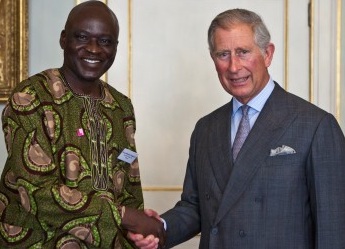The Toyola Money Box: The BoP marketing tactic you wish you’d thought of
First, it’s not actually a box.
It’s a tin.
A condensed milk tin with a hole in the top – empty, collected from garbage dumps by local kids.
Slap a label on it that reads “Toyola Money Box” with some masking tape and you have one of the most beautiful pieces of marketing for products at the base of the pyramid.
Just what does this box do?
Toyola salespeople sell cook stoves and solar lanterns. They sell these products in rural Ghana to poor, savvy, smart consumers. Consumers who don’t often leap at the opportunity to buy something they don’t think they need, from someone they don’t know, at a price they cannot readily afford. Consumers who are too smart and too poor to take risks.
Toyola sales people understand this. They come from the communities where they sell. And oh my, do they ever sell. Upwards of 4,400 stoves a year, each.
The Toyola salesperson visits the consumers’ house. The consumer is not so sure about the cook stove deal. Maybe an aid organization gave stoves away in that neighborhood before (“so why should I buy one if they may come for free?”). Maybe a worse product was already oversold in this neighborhood (“I tried one before and it was crap”). Maybe they just like three-stone fires.
The salesperson makes an offer: buy the cook stove today in cash and get a 10 percent discount. Or keep the stove for a month to test it out (and pay the extra 10 percent). Over 90 percent of customers opt to test the stove and pay the 10 percent premium. They are too poor to take a risk.
 Salespeople leave customers a Toyola Money Box. Every other day when they buy charcoal, customers put the money they save (about 50 percent a day) in the box. In a month when the salesperson comes back the customers open the box and immediately see the savings the stove has brought them. It’s a visible way to demonstrate product benefits. It helps customers save the money necessary to buy the product. The worlds of marketing (making the sale) and finance (making the sale possible) unite here in a beautiful way.
Salespeople leave customers a Toyola Money Box. Every other day when they buy charcoal, customers put the money they save (about 50 percent a day) in the box. In a month when the salesperson comes back the customers open the box and immediately see the savings the stove has brought them. It’s a visible way to demonstrate product benefits. It helps customers save the money necessary to buy the product. The worlds of marketing (making the sale) and finance (making the sale possible) unite here in a beautiful way.
I asked Suraj Wahab, the founder of Toyola, what he does with all the stoves that are returned after one month. Turns out that it isn’t really a problem: he’s personally only had one stove returned so far.
It works even better with solar lanterns – instead of 50 percent savings a day on charcoal, customers save 100 percent of their daily expenditure on kerosene.
(Above: Suraj Wahab meets the Prince of Wales)
This is not rocket science. Wahab is part of the cadre that Rory Sutherland envisioned in his TED talk: “a class of people who have immense power, but no money at all.” The ‘immense power’ comes from living in and understanding a market with seemingly boundless demand. And Wahab readily states that he’s never had money for traditional marketing. He finds ways to let the products sell themselves and show their real benefits.
Wahab‘s company now sells more 100,000 stoves a year manufactured in Ghana, Togo, and Nigeria. His main organizational problem: “We cannot find enough materials to build stoves fast enough to sell to our customers,” Wahab says.
Author’s note: This post reflects the author’s views alone and does not necessarily represent Unilever’s strategies, positions, or opinions. If you are enough of a behavior change geek to get extremely excited about these approaches, I’d highly recommend checking out Heather Esper’s recent post on the subject as well.
- Categories
- Technology
